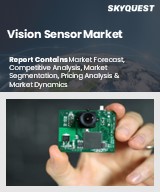
Report ID: SQMIG45J2310
Skyquest Technology's expert advisors have carried out comprehensive global market analysis on the vision sensor market, covering regional industry trends and market insights. Our team of analysts have conducted in-depth primary and secondary research to provide regional industry analysis and forecast of vision sensor market across North America, South America, Europe, Asia, the Middle East, and Africa.
As a result of leading manufacturers and high R&D spending, North America is a leading hub for technical innovation in vision sensors. Demand for high-performance vision sensors is prompted by the high focus on integrating AI, autonomous vehicles, and industrial automation in the region. Vision sensors are increasingly applied in the defense, healthcare, and logistics industries, which is contributing to boosting operational safety and efficiency in these industries.
The United States dominates the North American vision sensor market due to its innovations in robotics, autonomous vehicles, and smart production. In 2024, Tesla pushed ahead object recognition and lane changing features by combining AI-capable vision sensors with its Full Self-Driving (FSD) technology. Amazon extended the application of vision sensors across its warehouses to enhance supply chain operations by facilitating easier shipping sorting, inspection and ensuring their quality.
Especially in the areas of autonomous robots, medicine, and precision farming, Canada is becoming a top consumer of vision sensors. Vision sensors for crop monitoring powered by AI were launched by one of Canada's leading agritech companies in 2025, increasing automated harvesting effectiveness. Canadian hospitals have also begun using vision sensors in robot-assisted surgery to enhance precision and reduce patients' recovery time to improve accuracy and reduce recovery times for patients.
As a result of its rapid industrialization, growing automation, and growth in the manufacturing of consumer electronics, Asia-Pacific is the largest vision sensor market. China, Japan, and India are making significant investments in AI-enabled vision systems and intelligent manufacturing. Companies are being compelled to implement vision sensors for enhanced quality inspection and defect detection because of the need for high-speed, high-accuracy production.
The expansion of India's automotive, electronics, and infrastructure industries is fueling an increase in the use of vision sensors. In 2024, Tata Motors enhanced fault detection and safety inspections on their electric vehicle production lines by using AI-based vision sensors. To enhance city safety, the government's smart city initiatives also involve the use of vision sensors in security monitoring and traffic management systems.
China's strong electronics and industrial automation sectors enable it to dominate the Asia-Pacific vision sensor market. In 2025, Huawei launched a vision sensor system that incorporates AI for smart city use in enhancing traffic control and real-time facial recognition. Moreover, BYD, the top electric vehicle manufacturer, enhanced road safety and navigation by incorporating visual sensors into its autonomous driving technology.
Europe is one of the major vision sensor markets, with emphasis on robotics, industrial automation, and automotive development. Governments in the region are encouraging AI and Industry 4.0 programs, which is speeding up the adoption of vision sensors in smart production, logistics, and healthcare. The growth of applications for vision sensors is also being supported by increasing demand for efficient and sustainable production processes.
The application of vision sensors in autonomous cars, retail automation, and logistics is increasingly expanding in the UK. Ocado maximized order picking and stock management in 2024 by applying vision sensors to its automated distribution centers. Due to the nation's push for autonomous public transport, AI-based vision sensors are now implemented in smart mobility initiatives for pedestrian detection and vehicle navigation.
France is at the leadership in applying vision sensors to its manufacturing, automotive, and aerospace industries. Vision sensors of high-end were incorporated by Airbus into airplane inspection systems in 2025, which minimized human testing needs and enhanced maintenance efficiency. Vision sensors powered by AI are also being applied across assembly lines by its domestic automakers, such as Peugeot and Renault, to enhance the accuracy and quality of their production.
REQUEST FOR SAMPLE
Global Vision Sensor Market size was valued at USD 1.3 Billion in 2023 and is poised to grow from USD 1.5 Billion in 2024 to USD 3.73 Billion by 2032, growing at a CAGR of 11.66% in the forecast period (2025-2032).
Large players in the competitive vision sensor market are expanding R&D and strategic collaborations. AI-driven vision sensors are being launched by players such as Cognex, Omron, and Keyence with a view to enhance performance. Mergers enable corporations to gain better access to markets, while collaborations between automation and sensor firms are enhancing product ability. Further, companies are concentrating on energy-efficient and high-resolution vision sensors to address changing industrial needs. 'SAP', 'Deloitte', 'Amplitude', 'Pegasystems', 'AppLearn Ltd.', 'Inline Manual Ltd.', 'Newired Srl', 'Pendo.io Inc.', 'Toonimo', 'Userlane', 'WalkMe', 'Whatfix'
The demand for vision sensors is being propelled by increasing automation adoption in industries such as manufacturing, electronics, and automotive. Vision sensors are being utilized by companies to minimize human intervention and enhance productivity by automating quality inspection, defect inspection, and robot guidance. The demand for smart vision sensors with AI and IoT capabilities is also being further driven by the growth of Industry 4.0 projects across the globe.
Intelligent Decision-Making with AI-Based Vision Sensors: Through facilitating real-time analysis and decision-making, artificial intelligence (AI) for vision sensors is transforming several industries. Vision sensors based on AI lower errors and boost automation in the manufacturing, shipping, and healthcare industries by classifying objects, identifying anomalies, and offering predictive analysis.
How Is North America Leading the Vision Sensor Market?
Want to customize this report? This report can be personalized according to your needs. Our analysts and industry experts will work directly with you to understand your requirements and provide you with customized data in a short amount of time. We offer $1000 worth of FREE customization at the time of purchase.
Feedback From Our Clients

Report ID: SQMIG45J2310
sales@skyquestt.com
USA +1 351-333-4748